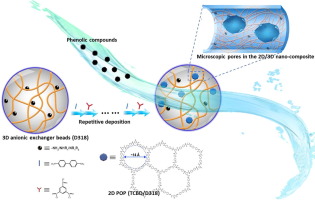杨朕副教授、杨维本教授课题组在CHEMICAL ENGINEERING JOURNAL发表研究论文
Efficient adsorption of four phenolic compounds using a robust nanocomposite fabricated by confining 2D porous organic polymers in 3D anion exchangers
Yang, Z (Yang, Zhen)[ 1 ]*(杨朕); Zhang, Y (Zhang, Yi)[ 1 ] ; Wang, XZ (Wang, Xuzeng)[ 1 ] ; Tian, ZQ (Tian, Ziqi)[ 3 ] ; Yang, WB (Yang, Weiben)[ 1 ]*(杨维本); Graham, NJD (Graham, Nigel J. D.)[ 2 ]*
[ 1 ] Nanjing Normal Univ, Jiangsu Prov Key Lab Mat Cycling & Pollut Control, Sch Chem & Mat Sci, Nanjing 210046, Peoples R China
[ 2 ] Imperial Coll London, Dept Civil & Environm Engn, London SW7 2AZ, England
[ 3 ] Chinese Acad Sci, Ningbo Inst Mat Technol & Engn, Ningbo 315000, Peoples R China
CHEMICAL ENGINEERING JOURNAL,202009,396,125296
A novel 2D/3D hybrid nanocomposite adsorbent (TCBD/D318) was synthesized by confining a 2D porous organic polymer (POP, TCBD) in pores of commercial 3D anionic exchanger beads (D318) using a facile repetitive deposition method, and evaluated for the removal of four phenolic contaminants (phenol, 1-naphthol, 4-nitrophenol and 4-chlorophenol) from water. The immobilization of TCBD in D318 conferred on the adsorbent a robust water stability, a rapid solid-liquid separation (in 10 s after dispersion in water), and an enhanced anti-self-aggregation property. The effects of pH, contaminant type, coexisting inorganic anions and natural organic matter (NOM) on adsorption performance were studied. TCBD/D318 exhibited high adsorption capacities (Q(e)) for all four phenolic contaminants, and these were only slightly influenced by pH and the presence of coexisting inorganic anions and NOM, due to the combined effects of multi-binding-interactions and hierarchical pore-structures. Another equally important merit of the TCBD/D318 was its remarkably improved utilization efficiency (atom economy) of functional groups. The adsorption mechanisms were investigated by a combination of physico-chemical model fitting, instrumental analysis and chemical computation. These displayed a hierarchical-pore-structure-induced multi-step diffusion adsorption involving multi-binding-interactions, principally electrostatic attraction, pi-pi interaction, and H-bonding; the contaminants were more inclined to be bound onto TC units of TCBD in the nanocomposite. Regeneration tests involving 10 adsorption-desorption cycles showed that TCBD/D318 maintained a high Q(e), confirming its effective reusability. The results have demonstrated the outstanding potential of TCBD/D318 for the removal of phenolic compounds from water, and more generally the possibilities of using POP-based 2D/3D hybrid nanocomposites in wider environmental applications.

文章链接:
https://www.sciencedirect.com/science/article/pii/S1385894720312882?via%3Dihub
版权与免责声明:本网页的内容由收集互联网上公开发布的信息整理获得。目的在于传递信息及分享,并不意味着赞同其观点或证实其真实性,也不构成其他建议。仅提供交流平台,不为其版权负责。如涉及侵权,请联系我们及时修改或删除。邮箱:sales@allpeptide.com